Introduction
In Taiwan, due to Chinese cultural tradition and rapid social-economic changes, gifted education and talent development have become one of the top priorities in educational planning in the last twenty years. Among many gifted/talented education programs, the Olympiad Program represents a new type of talent search that has been developed in coordination with International Math/Science Olympiads. In 1991, the first Taiwan team, composed of ten youngsters highly talented in math, participated in the third Asia-Pacific Math Olympiad. One year later, a team of six mathematically talented students attended the 33rd International Math Olympiad. Up to 1998, a total of 72 Math Olympians in Taiwan had the experience of going abroad and competing (some of them went twice). In 1992 and 1994, Taiwan teams started to participate in International Chemistry Olympiad (ICO) and International Physics Olympiad (IPO) competitions, respectively. It is important to know how the Olympians were shaped and what the Olympiad experience meant to them. Therefore, under the sponsorship of the National Science Council, R.O.C., the researchers conducted a series of follow-up studies to answer the following questions: (1) What are the Olympians' current statuses? (2) What family and school factors contribute to the development of their scientific talents? (3) What impact did the Olympiad program have on them?
The Math Olympians' study has been carried out (Wu, 1996; Wu & Chen, 1998). The current study, aimed at the science (both physics and chemistry) Olympians, seeks to explore the same questions.
Literature Review
According to Passow (1992), the test for educators is to create an environment that will facilitate students engaging in learning activities that will help them discover their potential and stimulate the pursuit of activities that will nurture this potential. Such a learning environment will require a variety of strategies and structures and will provide a balance between individual and independent study, on the one hand, and cooperative learning situations and group activities on the other (Passow, 1992; Walberg & Wang, 1994).
After studying the lives of exceptionally gifted persons, Pressey (1955) noted that all of these "geniuses" seemed to have (1) excellent and early opportunities for abilities to emerge with encouragement by families and friends; (2) participation with others that provided a basis for continuing stimulating relationships; and (3) stimulation through frequently and increasingly strong success opportunities.
Similarly, from his study of 120 "immensely talented" musicians, artists, athletes, mathematicians, and scientists, Bloom (1985) noted that there was strong evidence that no matter what the initial characteristics (or gifts) of the individuals, unless there is a long and intensive process of encouragement, nurturance, education, and training, the individual will not attain extreme levels of capability in these particular fields"(p.3). He concluded "that exceptional levels of talent development require certain types of environmental support, special experiences, excellent teaching, and appropriate motivational encouragement at each stage of development" (p.543). The Bloom study found certain values, such as the value of achievement and the importance of doing one's best, very important in these families.
Based on meta-analysis, Walberg (1984) proposed a Learning Productivity Model which included four environmental factors: home, classroom, peers, and television. He noted that three of them - the psychological climate of the classroom group, enduring affection and academic stimulation from adults at home, and association with an out-of-school peer group that possessed learning-related interests, goals, and activities - influence learning in both direct and indirect ways. Among the out-of-school factors, the home influences are especially powerful.
The learning environment of the Math/Science Olympians thus includes school influences, home influences, and special learning opportunities (the Olympiad activities).
Attitudes consist of cognitive (beliefs or knowledge), affective (emotional, motivational), and performance (behavior or action tendencies) components. With respect to the subject of math, the affective component is related to the feelings of like or dislike for the subject, while the cognitive component refers to beliefs in the value and utility of math/science. Both components have been stressed often. The relationship between students' attitudes toward math/science and their ability in the subject is dynamic and interactive in that individuals with low ability in math are likely to have more negative attitudes toward the subject. Similarly, those with negative attitudes are less inclined to make the effort to improve their math abilities (Aiken, 1985). On the other hand, the active encouragement of parents, teachers, and counselors seems to affect attitudes. A consistent finding of many investigations is that teachers who like math and do their best to make it interesting can create favorable attitudes and positive student motivation in the subject (Armstrong, 1980). Competition and group projects can also positively or negatively affect students' attitudes toward learning.
In Taiwan, the follow-up type studies for the gifted/talented was considered poor in both quantity and quality (Hsien, 1994; Wu, 1993), the follow-up term was short (e.g., Chen, 1995; Fang & Wei, 1991; Science Education Center, NTNU, 1993), and the method used was mainly the retrospective one (e.g., Chen, 1990). A long-term follow-up study is needed, especially for the extremely talented such as the math/science Olympians
Recently, a follow-up study of 36 Taiwan math Olympians (MOs) was conducted, using questionnaire survey and in-depth interview to collect the data (Wu, 1996; Wu & Chen, 1998). It was found that the MOs were all top university students for the time being; the majority was majoring in math; they were mostly the first-born child in small families and were "discovered" at an early age and had been in a gifted class; the SES of the MOs' families were varied, though the majority were high; their family support and learning environment were reported strong and positive; both the Olympians and their parents considered "encounter a good teacher" as the most important factor for the development of the MOs' math talents; the Olympiad experiences were, in general, positive to the subjects, especially in learning attitude toward math; on the other hand, there were almost no special programs designed for the Olympians during their college years; most had not yet shown special achievement other than math as they were still students; the Olympians were individuals with unique characteristics, although they were common in their great commitment to math.
This study basically used the same model and method of the above math Olympians' follow-up study, but the subjects were Taiwan Physics and Chemistry Olympians in stead of math Olympians.
Methods
In this study, the data were collected by means of questionnaire surveys and in-depth interviews.
Subjects
The subjects of this study were 32 Taiwan Physics and Chemistry Olympians (14 POs and 18 COs) who participated in the International Physics Olympiad (IPO) from 1994 to 1996 or the International Chemistry Olympiad (ICO) from 1992 to 1996. All subjects and their parents were invited to participate in this study. Only 3 of the Olympians were females. The survey was conducted in November 1996 to January 1997, when 3 (9%) were still senior high students. The Olympians' ages ranged from 18 years and 1 month to 24 years, with a median of 20 years and 11 months, in the time of January 1997. Up to September 1997, the beginning of the next academic year, all were undergraduate or graduate students. Most (10, or 71%) of the POs were majoring in physics, while most of the COs were majoring in chemistry (13, or 76%). Two COs were studying in USA top universities. For those who were studying in domestic universities, 28 out of 30 (or 93%) were accepted by the university without taking entrance examinations.
The selection of the POs and COs was based on a national talent search project carried on by National Taiwan Normal University (under the sponsorship of the Ministry of Education). Those who met one of the selected criteria were eligible to be the candidates (about 20 students). The candidates then participated in a science camp (nine days) that concentrated on the study of physics or chemistry. During the experience the candidates were observed and evaluated. There were 4 to 5 finalists. Only the finalists were asked to attend a semi-intensive training camp for one month before going abroad for the IPO or ICO competition.
The available student subjects were 31 as one CO refused to respond because of personal reason. The available parent subjects were 29, as 2 didn't return the questionnaire in addition to one whose child refused to respond.
Instrumentation
The instruments used in this study were basically the same as those used for the Math Olympians study (Wu, 1996; Wu & Chen, 1998), which were originally developed by Campbell (1996) for cross-cultural/national studies. The instruments included the following: (1) Olympians' questionnaire, (2) parents' questionnaire, (3) self-concept and attribution scales, and (4) family and school influence scales. The questionnaire/scales were translated into Chinese with minor necessary changes. The basic format of the Chinese versions remains the same as the original.
A semi-structured questionnaire, designed for in-depth interview in the Taiwan study, included the following themes: (1) family life and parental influences, (2) school life and academic interests, (3) pupil-teacher relationship and teacher influences, (4) peer relationship and social life, (5) learning method/style, (6) extra-curricula activities/interests, (7) "the computer and you", (8) impressions of the Olympiad, (9) opinions of gifted education, (10) brief description of one's self (anything), (11) views about "human life", and (12) career goals.
Procedures
First, the Chinese versions of the questionnaires/scales were developed and reviewed by two colleagues. Second, the subjects' addresses and basic data were collected with the assistance of their high school teachers and administrators (the 32 subjects were from 14 high schools, among them 13 were from the renowned Taipei Municipal Chien-Kuo High School). The questionnaires/scales were sent to the subjects and their parents with an invitation letter and small gifts (a pair of pens for the Olympians and a researcher' book concerning parenting for the parents). All available questionnaires/scales were returned in two weeks (the domestic ones) or one month (the overseas ones) without further phone reminders.
Eight graduate students were trained as field interviewers before going to visit the subjects. The targets of the interview were the Olympians, but not limited to them, in case their parents were also available. The interviews were tape-recorded and transcribed according to the themes mentioned above. The raw data of the questionnaire/scales were transferred onto scantron pages and machine scored. The quantitative data explained here are descriptive. The qualitative data based on interviews will also be presented and discussed.
Results and Discussion
The results are presented in nine sections. The final section contains a summary of the qualitative data.
Family Background
As shown in by Tables 1 and 2, most (77%) of the Olympians were the first-born children in small families (2.45 children/family). The socioeconomic status (SES), indexed 2 to 10, was determined by the father's occupational status (point 1 to 5) and educational attainment (point 1 to 5) in this study. In general, the Olympians' family SESs, with a mean of 7.03, were higher than most Taiwan students. However, it varied from the bottom (2) to the top (10). The monthly family income, with a median of about $2,500, surpassed the average family income in the Taipei area, which is about $2,000 for the time being. According to parents' reports, most of the Olympians owned their own house or apartment (none were renting), owned a car (72%), a TV (100%), a stereo or radio (97%), reference books (100%), encyclopedias (76%), and personal computer (83%). On average, there were between 100 to 300 books in the Olympians home when they were growing up. There were some slight discrepancies about the family resources reported by the Olympians and the parents, but in general it was evident that most of the Olympians came from professional and affluent families with many intellectual resources. However, two Olympians (6%) were from considerable low SES families with fewer books.
In terms of cultural aspects, most Olympians spoke one foreign language (77%), and two Chinese dialects (74%). While only one foreign language (English) is taught in school in Taiwan, 13% of the Olympians learned more foreign languages from their parents or from out-of-school programs. In addition, 65% of the Olympians played musical instruments.
There are connections between SES and children's' academic performance. However, it is probably the high quality of intellectual stimulation in the home environment (Bloom, 1985) that contributes to children's achievement, not SES itself. Some lower SES families did produce Olympian children, which tend to confirm this connection. Therefore, we should pay more attention to other dimensions of the family - the degree of intellectual stimulation supplied and the level of family support.
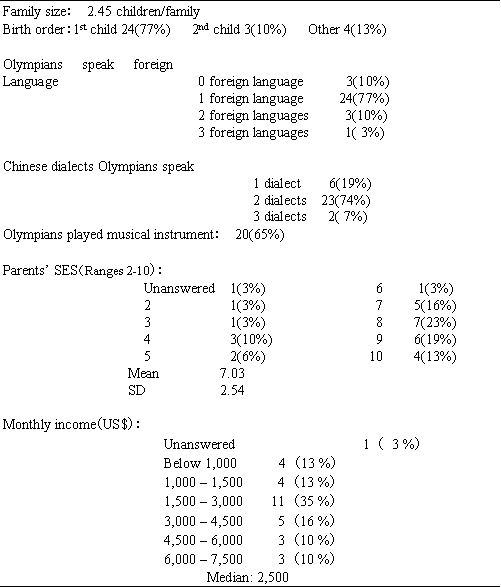
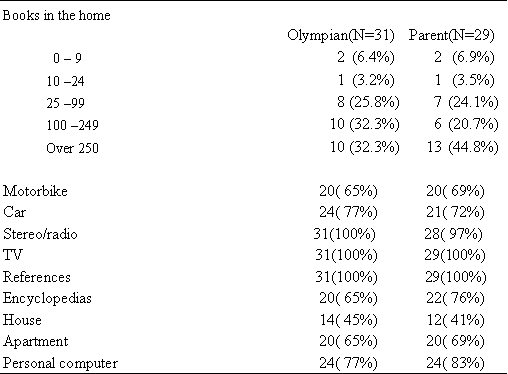
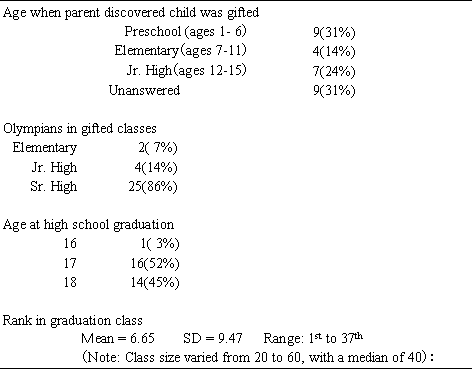
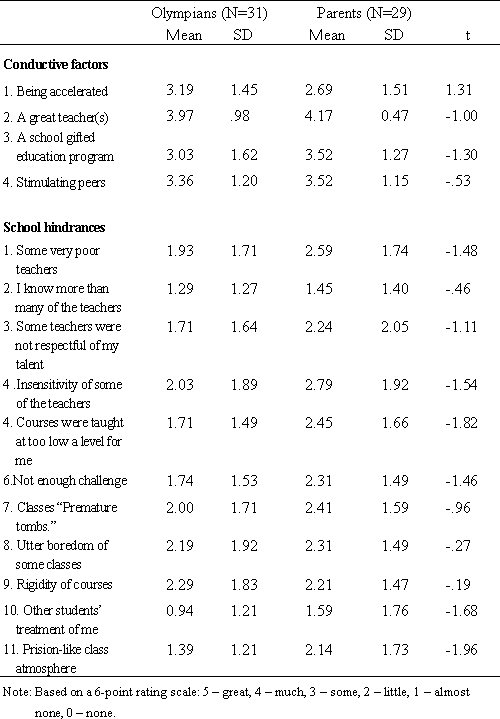
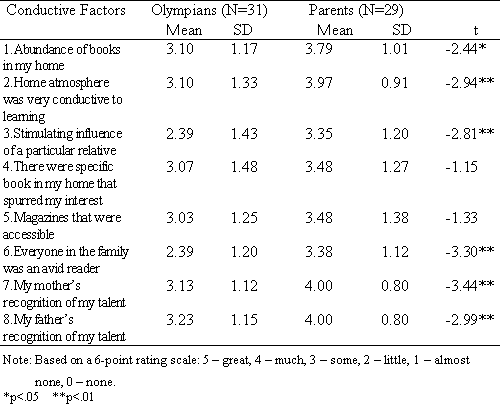
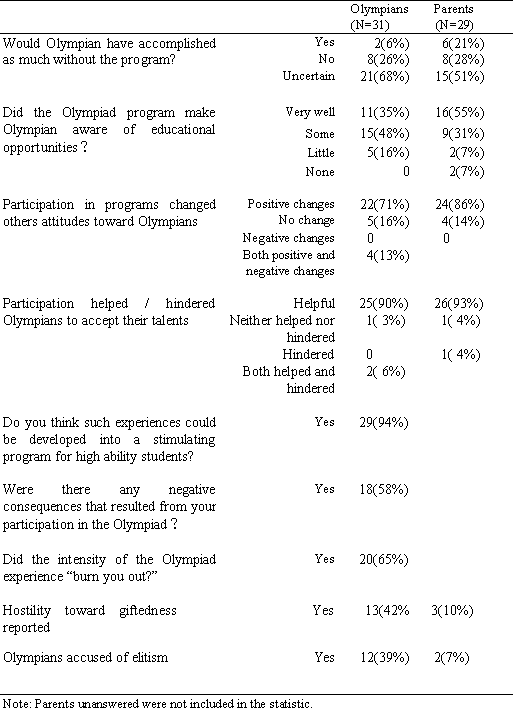
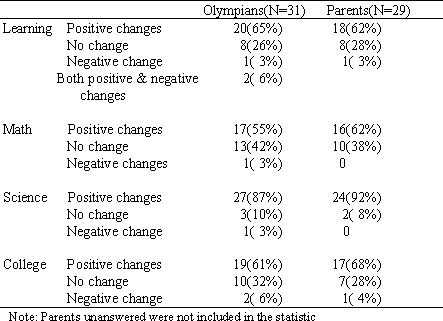
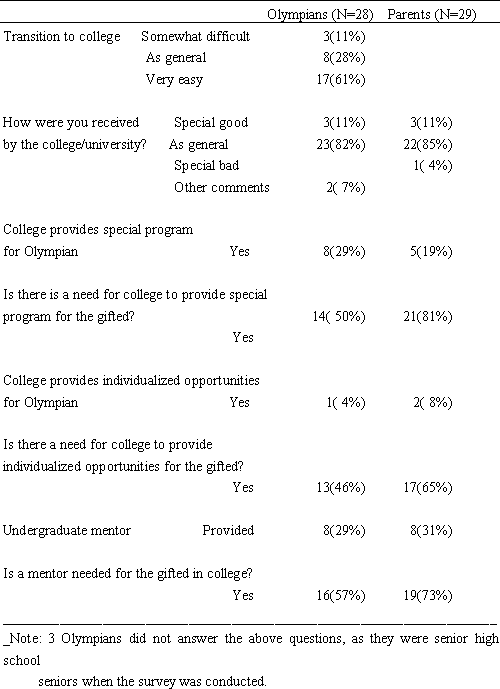
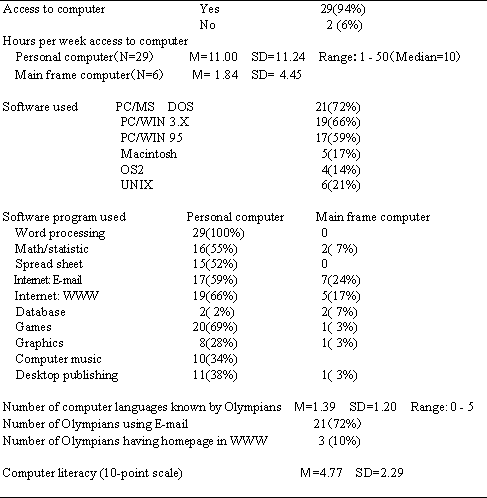

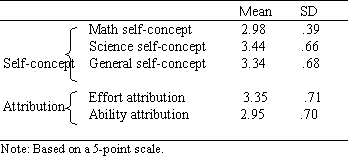
In Taiwan, due to Chinese cultural tradition and rapid social-economic changes, gifted education and talent development have become one of the top priorities in educational planning in the last twenty years. Among many gifted/talented education programs, the Olympiad Program represents a new type of talent search that has been developed in coordination with International Math/Science Olympiads. In 1991, the first Taiwan team, composed of ten youngsters highly talented in math, participated in the third Asia-Pacific Math Olympiad. One year later, a team of six mathematically talented students attended the 33rd International Math Olympiad. Up to 1998, a total of 72 Math Olympians in Taiwan had the experience of going abroad and competing (some of them went twice). In 1992 and 1994, Taiwan teams started to participate in International Chemistry Olympiad (ICO) and International Physics Olympiad (IPO) competitions, respectively. It is important to know how the Olympians were shaped and what the Olympiad experience meant to them. Therefore, under the sponsorship of the National Science Council, R.O.C., the researchers conducted a series of follow-up studies to answer the following questions: (1) What are the Olympians' current statuses? (2) What family and school factors contribute to the development of their scientific talents? (3) What impact did the Olympiad program have on them?
The Math Olympians' study has been carried out (Wu, 1996; Wu & Chen, 1998). The current study, aimed at the science (both physics and chemistry) Olympians, seeks to explore the same questions.
Literature Review
According to Passow (1992), the test for educators is to create an environment that will facilitate students engaging in learning activities that will help them discover their potential and stimulate the pursuit of activities that will nurture this potential. Such a learning environment will require a variety of strategies and structures and will provide a balance between individual and independent study, on the one hand, and cooperative learning situations and group activities on the other (Passow, 1992; Walberg & Wang, 1994).
After studying the lives of exceptionally gifted persons, Pressey (1955) noted that all of these "geniuses" seemed to have (1) excellent and early opportunities for abilities to emerge with encouragement by families and friends; (2) participation with others that provided a basis for continuing stimulating relationships; and (3) stimulation through frequently and increasingly strong success opportunities.
Similarly, from his study of 120 "immensely talented" musicians, artists, athletes, mathematicians, and scientists, Bloom (1985) noted that there was strong evidence that no matter what the initial characteristics (or gifts) of the individuals, unless there is a long and intensive process of encouragement, nurturance, education, and training, the individual will not attain extreme levels of capability in these particular fields"(p.3). He concluded "that exceptional levels of talent development require certain types of environmental support, special experiences, excellent teaching, and appropriate motivational encouragement at each stage of development" (p.543). The Bloom study found certain values, such as the value of achievement and the importance of doing one's best, very important in these families.
Based on meta-analysis, Walberg (1984) proposed a Learning Productivity Model which included four environmental factors: home, classroom, peers, and television. He noted that three of them - the psychological climate of the classroom group, enduring affection and academic stimulation from adults at home, and association with an out-of-school peer group that possessed learning-related interests, goals, and activities - influence learning in both direct and indirect ways. Among the out-of-school factors, the home influences are especially powerful.
The learning environment of the Math/Science Olympians thus includes school influences, home influences, and special learning opportunities (the Olympiad activities).
Attitudes consist of cognitive (beliefs or knowledge), affective (emotional, motivational), and performance (behavior or action tendencies) components. With respect to the subject of math, the affective component is related to the feelings of like or dislike for the subject, while the cognitive component refers to beliefs in the value and utility of math/science. Both components have been stressed often. The relationship between students' attitudes toward math/science and their ability in the subject is dynamic and interactive in that individuals with low ability in math are likely to have more negative attitudes toward the subject. Similarly, those with negative attitudes are less inclined to make the effort to improve their math abilities (Aiken, 1985). On the other hand, the active encouragement of parents, teachers, and counselors seems to affect attitudes. A consistent finding of many investigations is that teachers who like math and do their best to make it interesting can create favorable attitudes and positive student motivation in the subject (Armstrong, 1980). Competition and group projects can also positively or negatively affect students' attitudes toward learning.
In Taiwan, the follow-up type studies for the gifted/talented was considered poor in both quantity and quality (Hsien, 1994; Wu, 1993), the follow-up term was short (e.g., Chen, 1995; Fang & Wei, 1991; Science Education Center, NTNU, 1993), and the method used was mainly the retrospective one (e.g., Chen, 1990). A long-term follow-up study is needed, especially for the extremely talented such as the math/science Olympians
Recently, a follow-up study of 36 Taiwan math Olympians (MOs) was conducted, using questionnaire survey and in-depth interview to collect the data (Wu, 1996; Wu & Chen, 1998). It was found that the MOs were all top university students for the time being; the majority was majoring in math; they were mostly the first-born child in small families and were "discovered" at an early age and had been in a gifted class; the SES of the MOs' families were varied, though the majority were high; their family support and learning environment were reported strong and positive; both the Olympians and their parents considered "encounter a good teacher" as the most important factor for the development of the MOs' math talents; the Olympiad experiences were, in general, positive to the subjects, especially in learning attitude toward math; on the other hand, there were almost no special programs designed for the Olympians during their college years; most had not yet shown special achievement other than math as they were still students; the Olympians were individuals with unique characteristics, although they were common in their great commitment to math.
This study basically used the same model and method of the above math Olympians' follow-up study, but the subjects were Taiwan Physics and Chemistry Olympians in stead of math Olympians.
Methods
In this study, the data were collected by means of questionnaire surveys and in-depth interviews.
Subjects
The subjects of this study were 32 Taiwan Physics and Chemistry Olympians (14 POs and 18 COs) who participated in the International Physics Olympiad (IPO) from 1994 to 1996 or the International Chemistry Olympiad (ICO) from 1992 to 1996. All subjects and their parents were invited to participate in this study. Only 3 of the Olympians were females. The survey was conducted in November 1996 to January 1997, when 3 (9%) were still senior high students. The Olympians' ages ranged from 18 years and 1 month to 24 years, with a median of 20 years and 11 months, in the time of January 1997. Up to September 1997, the beginning of the next academic year, all were undergraduate or graduate students. Most (10, or 71%) of the POs were majoring in physics, while most of the COs were majoring in chemistry (13, or 76%). Two COs were studying in USA top universities. For those who were studying in domestic universities, 28 out of 30 (or 93%) were accepted by the university without taking entrance examinations.
The selection of the POs and COs was based on a national talent search project carried on by National Taiwan Normal University (under the sponsorship of the Ministry of Education). Those who met one of the selected criteria were eligible to be the candidates (about 20 students). The candidates then participated in a science camp (nine days) that concentrated on the study of physics or chemistry. During the experience the candidates were observed and evaluated. There were 4 to 5 finalists. Only the finalists were asked to attend a semi-intensive training camp for one month before going abroad for the IPO or ICO competition.
The available student subjects were 31 as one CO refused to respond because of personal reason. The available parent subjects were 29, as 2 didn't return the questionnaire in addition to one whose child refused to respond.
Instrumentation
The instruments used in this study were basically the same as those used for the Math Olympians study (Wu, 1996; Wu & Chen, 1998), which were originally developed by Campbell (1996) for cross-cultural/national studies. The instruments included the following: (1) Olympians' questionnaire, (2) parents' questionnaire, (3) self-concept and attribution scales, and (4) family and school influence scales. The questionnaire/scales were translated into Chinese with minor necessary changes. The basic format of the Chinese versions remains the same as the original.
A semi-structured questionnaire, designed for in-depth interview in the Taiwan study, included the following themes: (1) family life and parental influences, (2) school life and academic interests, (3) pupil-teacher relationship and teacher influences, (4) peer relationship and social life, (5) learning method/style, (6) extra-curricula activities/interests, (7) "the computer and you", (8) impressions of the Olympiad, (9) opinions of gifted education, (10) brief description of one's self (anything), (11) views about "human life", and (12) career goals.
Procedures
First, the Chinese versions of the questionnaires/scales were developed and reviewed by two colleagues. Second, the subjects' addresses and basic data were collected with the assistance of their high school teachers and administrators (the 32 subjects were from 14 high schools, among them 13 were from the renowned Taipei Municipal Chien-Kuo High School). The questionnaires/scales were sent to the subjects and their parents with an invitation letter and small gifts (a pair of pens for the Olympians and a researcher' book concerning parenting for the parents). All available questionnaires/scales were returned in two weeks (the domestic ones) or one month (the overseas ones) without further phone reminders.
Eight graduate students were trained as field interviewers before going to visit the subjects. The targets of the interview were the Olympians, but not limited to them, in case their parents were also available. The interviews were tape-recorded and transcribed according to the themes mentioned above. The raw data of the questionnaire/scales were transferred onto scantron pages and machine scored. The quantitative data explained here are descriptive. The qualitative data based on interviews will also be presented and discussed.
Results and Discussion
The results are presented in nine sections. The final section contains a summary of the qualitative data.
Family Background
As shown in by Tables 1 and 2, most (77%) of the Olympians were the first-born children in small families (2.45 children/family). The socioeconomic status (SES), indexed 2 to 10, was determined by the father's occupational status (point 1 to 5) and educational attainment (point 1 to 5) in this study. In general, the Olympians' family SESs, with a mean of 7.03, were higher than most Taiwan students. However, it varied from the bottom (2) to the top (10). The monthly family income, with a median of about $2,500, surpassed the average family income in the Taipei area, which is about $2,000 for the time being. According to parents' reports, most of the Olympians owned their own house or apartment (none were renting), owned a car (72%), a TV (100%), a stereo or radio (97%), reference books (100%), encyclopedias (76%), and personal computer (83%). On average, there were between 100 to 300 books in the Olympians home when they were growing up. There were some slight discrepancies about the family resources reported by the Olympians and the parents, but in general it was evident that most of the Olympians came from professional and affluent families with many intellectual resources. However, two Olympians (6%) were from considerable low SES families with fewer books.
In terms of cultural aspects, most Olympians spoke one foreign language (77%), and two Chinese dialects (74%). While only one foreign language (English) is taught in school in Taiwan, 13% of the Olympians learned more foreign languages from their parents or from out-of-school programs. In addition, 65% of the Olympians played musical instruments.
There are connections between SES and children's' academic performance. However, it is probably the high quality of intellectual stimulation in the home environment (Bloom, 1985) that contributes to children's achievement, not SES itself. Some lower SES families did produce Olympian children, which tend to confirm this connection. Therefore, we should pay more attention to other dimensions of the family - the degree of intellectual stimulation supplied and the level of family support.
| Table 1 Family Background of Physics and Chemistry Olympians in Taiwan |
|
Table 2 Socio-economic Resources of the Physics and Chemistry Olympians Families in Taiwan |
| Schooling Did the Olympians have special schooling experiences (see Table 3 and 4)? Nearly half of the parents of the Olympians discovered their child was gifted (45%) before he or she entered junior high school. Some families made this discovery during the junior high year (24%), but there were also some that were unsure about the time (31%). Although all of the Olympians attended public schools, only 7% were enrolled in gifted classes during the elementary school years. The enrollment rate increased at the junior high level (14%) and at the senior high school level (86%). That means 86% of the Olympians were selected from talented math/science classes in14 senior high schools around Taiwan. In Taiwan, programs for the gifted are organized as "special classes" and can be either homogeneous classes or pull-out program. These programs formally began for elementary schools in 1973, for junior high schools in 1979, and for senior high schools in 1982. Up to 1997, there were 68 elementary schools, 35 junior high schools, and 19 senior high schools that had special classes for the intellectually gifted or for mathematically/scientifically talented students (Ministry of Education, R.O.C., 1998). In most cases, only the top 2 or 3% of the students in very large schools (exceeding 2,000 students) are selected for these special classes. This means that many scientifically talented students do not receive enriched training or specialized opportunities to develop their talent. However, the special classes do provide stimulating learning experiences and are, in general, enjoyed by the students. About half of the Olympians graduated from the high school at the normal age of 18 (45%). However, over half of them graduated either one year earlier (52%) or two years earlier (3%). Most of the Olympians ranked above average in the gifted class or were top students in the regular class. However, the variation was great, ranging from 1st to 37th of the class. The Olympians perceived conductive influences and few hindrances in their schools (see Table 4). There was a great congruence of perceptions between the Olympians and their parents in these regards. For example, both the Olympians and their parents considered "encounter a good teacher" as the most important factor for the development of the Olympians' scientific talents. The schooling experience seemed to be positive for the development of their talents. The Olympians schooling was somewhat different from that of non-Olympiad students. Their talents were discovered at an early age. However, most of them did not participate in any special programs in their elementary schools or junior high schools. Their families likely assumed the major responsibility in satisfying their special needs when they were young. At the senior high level they did have more opportunities to gain access to a more structured and enriched learning environment, wherein they were selected to participate in the Olympiad program. Both the Olympians and their parents considered "encounter a good teacher" as the most important factor for the development of the Olympians' scientific talent. The impact of schooling on their talent development was, in general, positive. This is in congruence with previous studies (e.g., Bloom, 1985; Wu & Chen, 1998) and indicates that a good teacher is really a critical factor contributing to student's motivation and achievement in learning. Family support and teaching play a critical role for children's growth in their early ages, while the quality of schooling has an increasing effect on students' cognitive development in later years. |
|
Table 3 Schooling of the Physics and Chemistry Olympians in Taiwan |
|
Table 4 Perceptions of Influences of School |
|
Family Processes What is the impact of the family processes, as compared to schooling, on the development of the Olympians' talent? Table 5 shows the results. In general, both the Olympians' perception and their parents' perception of family influences were positive, almost as positive as school influences. It is interesting to note that parents perceived higher conductive home atmosphere than the Olympians did. In other words, parents seemed to be more positive in their feedback about family influences than the Olympians. In particular, according to parent's perception, recognition of their children's talent, creating a good home atmosphere, and providing abundant books were the major contributions they did to their children. Parents were obviousely pleased by their children's achievement and enjoyed self-rewarding, although their children's appreciations did not match as much. |
|
Table 5 Perceptions of Influences of Home |
| On the basis of these findings, it can be said that families probably play the same important role as schools in the development of the Olympians' potential. The Olympians' families supplied high levels of psychological support and reading materials. These combinations provided a stimulating and supportive environment for the development of the Olympians' talent, especially in their early years. Influences of Physics and Chemistry Olympiad Program What influences did the Olympiad program have on the achievement and attitudes of the participants? Tables 6 and 7 reveal the following results. Most of the Olympians (68%) and their parents (51%) felt uncertain about the contribution of the Olympiad program to the Olympians' current accomplishment although about one-fourth of them assumed the contribution. Most Olympians (83%) reported that the program made them aware of better educational opportunities. The parents' favorable opinion in this regard was even higher (86%). Most Olympians (71%) reported positive changes in others' attitudes toward them by participating in the program. Again, the parents' positive response to this item was even higher (86%). Most of the Olympians (90%) and their parents (93%) said that participation in the program helped the Olympians accept their talents. Ninety-four percent of the Olympians believed that their training experiences could be developed into a stimulating program for high-ability science students. On the other hand, 58% of the Olympians reported negative side effects of the Olympiad program, 65% of them felt "burn out" by the intensity of the Olympiad experience, 42% of them reported experiencing hostility toward their giftedness, and 39% of them were accused of elitism. The Olympiad program provided rewarding experiences for the Olympians. The Olympiad program is not only a competitive program, it provides a variety of learning opportunities, including independent study, creative problem-solving, peer discussion, and challenge. It helped Olympians become aware of educational opportunities, positively changed others' attitudes toward the Olympians, and helped them accept their own talents. In addition, the program helped to considerably improve the Olympians' learning attitudes, especially toward science (87% positive changes). However, there were negative side effects for many Olympians and some experienced hostility or accusations of elitism. Therefore, it seems that there was a like-and-dislike complex existed in many Olympians. The negative side effects seem more serious than the findings shown in the previous math Olympians study (Wu, 1996; Wu & Chen, 1998) and should not be ignored. |
|
Table 6 Taiwan Olympians' Assessment of Olympiad Program |
|
Table 7 Attitude Changes of the Olympians after Participation in Physics and Chemistry Olympiad Program |
|
College Life The Olympians were admitted to the elite universities without great difficulty (Table 8). Actually, most of them were accepted by universities through a special award program provided by the Ministry of Education. Through this program, those who are IPO or ICO winners are eligible to enter a special field of their interest and/or talent in the university without taking the joint entrance examination. Unfortunately, like the math Olympians, the POs and COs reported that few (29%) of the universities provided special programs for them. The same situation is true for individualized educational opportunities (4% only) and mentorships (29%). This is a pity and has obviously frustrated the Olympians. However, many Olympians also reported that they soon became accustomed to the new environment by finding their own interests and/or doing their own studies. They found that previous Olympiad experience were very useful in helping them to think for themselves and, therefore, the Olympians' need for a mentorship (57%) was not as high as it was expected, and also not as high as their parents' opinion (73%). |
|
Table 8 Taiwan Physics and Chemistry Olympians in College |
|
Computer Literacy The computer literacy of the Olympians varied according to the Olympians' personal interest (Table 9). As personal computer becomes very popular in Taiwan, most (94%) of the Olympians had access to computer, with an average of 11 hours per week spent on personal computer; 72% of them were using e-mail. Most of them used PC/MS (72%) or PC/WIN (66%) software for world processing (100%), playing games (69%), accessing the internet (66%), etc. The reported computer literacy was modest (average of 4.77 in a 10-point scale). In general, the computer literacy of the POs and COs was obviously better than that found in Math Olympians study (Wu, 1996; Wu & Chen, 1998. |
|
Table 9 Taiwan Physics and Chemistry Olympians Computer Literacy |
|
Academic Productivity The Taiwan Olympians were still school/university students at the time the study was underway. According to their report (see Table 10), they did not have significant academic productivity. When the survey was conducted, only 9 Olympians had published articles, 6 had published research papers, and 1 had published a book. It was obvious that they were mainly "knowledge consumers" rather than "producers of knowledge" for the time being. It is hoped that in the near future they will become more productive. On the other hand, this low level of productivity may be the result of lacking encouragement by the academic community in Taiwan. |
|
Table 10 Accomplishment of Taiwan Physics and Chemistry Olympians |
|
Self-concept and Attribution Concerning the Olympians' self-concept and attribution, Table 11 indicates that the Olympians scored highly in terms of their science self-concept and general self-concept (averages of 3.44 and 3.43 in a 5-point scale, respectively). It appears that the POs and COs were not only confident in their science abilities, but their level of self-esteem was also high. On the other hand, the Olympians seemed to attribute their achievement more to effort (an average of 3.35 in a 5-point scale) than to ability (an average of 2.95). |
|
Table 11 Taiwan Physics and Chemistry Olympians' Self-concept and Attributions |
|
Qualitative Data There are abundant data collected from the in-depth interviews. According to the analysis of personal and environmental factors, there were great similarities as well as differences among the Olympians. The findings are valuable in terms of understanding and counseling physics and chemistry Olympians. Following are some summaires and comparisons. Similarities
Differences
As far as personal factors were concerned, there were more commonalities in cognitive quality among physics and chemistry Olympians. Generally, most of them showed their strong curiosities and interests in science since childhood. They liked to think and learn actively, and they were enthusiastic and committed to academic research. However, there were great differences among these gifted students in the aspects of academic achievement, creativity and computer literacy. There were few similarities in the aspect of interpersonal relationships. Some were very social, had various interests, strong abilities, and participated in many activities, some were quiet, reserved and not articulate. As for athletics and social science, individuals performed differently. As far as environmental factors were concerned, quite many beneficial factors promoted the development of the Olympians' talents in physics and chemistry. Some parents were educators, and they taught children with open and warm attitude. Besides, most Olympians were first-born child and their siblings also had outstanding achievements. However, there were some differences in terms of socioeconomic status, book and equipment resources. Most came from higher SES families, but some did not. The guidance of good teachers, the provision of equipment in gifted classes, and the experiences of participating in physics and chemistry Olympiad were influential factors to most Olympians in their course of learning science. On the contrary, the orientation of passing entrance examination in middle schools was unfavorable to their talent development. In addition, the opinions to teachers and the influence of peers had different impact on individuals As to social factors, most Olympians indicated that basic science was ignored prevailingly by the society while medical school was valued substantially as the best major by many teachers and parents. They were somewhat frustrated by the conflicts between inner motivation and outer incentives. If education wants talent students to fulfill their potential, the social value system regarding learning and career development out to be reexamined and, even, revised. Conclusion and Suggestions In conclusion, although the Olympians were common in a great commitment and achievement in sciences, they are individuals with unique characteristics. They benefited from a supportive home atomosphere, although few were from low SES families. Most of them felt lucky to encounter "good teachers", but many were confused by the pragmatic social value imposing on them and interferring their pure academic research interest. The Olympiand experiences were in general challenging and rewarding; however, there were also some negative side effects which seemed to be more serious than what had experienced by the Math Olympians. There was a great congruence of the findings with the previous follow-up study of Taiwan Mathematics Olympians (Wu & Chen, 1998). The following suggestions are made based on the findings of this study. It is basically for the potential development of the scientifically talented individuals as well as the national development in Taiwan. They may be applicable to other societies too, the Chinese societies in particular.
|
|
REFERENCES |
|
Aiken, L.R. (1985). Mathematics - attitude towards. In T. Husen and T.N. Postlethwaite (Eds.), International encyclopedia of education (Pp. 3233-36). Oxford: Pergamon Press.
Armstrong, J.M. (1980). Achievement and participation of women in mathematics. Denver, CO: Report of a two-year study funded by the National Institute of Education (Rep. 10 - MA-00), Education Commission of States.
Bloom, B. S. (Ed.), (1985). Developing talent in young people. New York: Ballantine Books.
Campbell, J. R. (l996). Developing cross-national instruments: using cross-national methods and procedures. International Journal of Educational Research, 25:6, 485-496.
Chen, C.Y. (1990). Career development and its influencing factors of high school gifted students. Unpublished master thesis, National Taiwan Normal University.
Chen, J.D. (1995). Academic performance of the math Olympians. Unpublished National Science Council project report. Taipei: Science Education Center, National Taiwan Normal University. (In Chinese)
Fang, T.S., & Wei, M.T. (1991). Characteristics of and education for the mathematically and scientifically talented: View from a follow-up study for the senior high juniors. Taiwan Education, 486, 1-5. (In Chinese)
Hsien, C. C. (1994). The effect of high school math and science gifted education. Unpublished doctoral dissertation, National Chang-Hua Normal University. (In Chinese)
Ministry of Education, R.O.C. (1998). Educational statistics in the Republic of China. Taipei: Author.(In Chinese)
Passow, A.H. (1992). Growing up gifted and talented: Schools, families and communities. Paper presented at the 2nd Asian Conference on Giftedness, Taipei, Taiwan, July 12-15, 1992.
Pressey, S.L. (1955). Concerning the nature and nurture of genius. Scientific Monthly, 81, 123-129.
Science Education Center, National Taiwan Normal University (1993). The 1993 follow-up study of the scientifically talented high school students. Taipei: Author. (In Chinese)
Walberg, H.J. (1984). Improving the productivity of America's schools. Educational Leadership, 42(8), 19-30.
Walberg, H.J., & Wang, M.C. (1994). Effective educational practices and provisions for individual differences. Taipei, Taiwan: Taiwan Provincial Institute for Elementary School Teachers' Inservice Education.
Wu, W.T. (1993). Retrospection of research on and education for gifted children. Invited keynote paper presented at the Symposium for the 15th Anniversary of Research and Education for Gifted Children in China, Beijing, China, October 11-13, 1993. (In Chinese)
Wu, W.T. (1996).Growing up in Taiwan: The impact of environmental influences on the Math Olympians. International Journal of Educational Research, 25:6, 479-484.
Wu, W.T., & Chen, J.D. (1998). A follow-up study of Taiwan Math Olympians - The environmental influences. Bulletin of Special Education, 16, 347-366. (In Chinese)
|
|
*Originally published in 1999 in Chinese at Bulletin of Special Education (National Taiwan Normal University), 17, 315-341. **Wu-Tien Wu is a professor of the Department of Special Education, National Taiwan Normal University, Taipei, Taiwan, R.O.C.. ***Jau D. Chen is a professor of the Department of Mathematics, National Taiwan Normal University, Taipei, Taiwan, R.O.C. |














